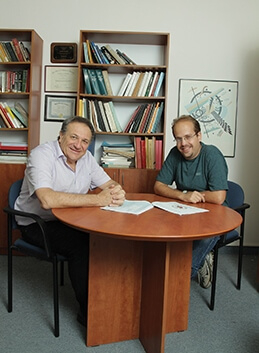Do the laws of thermodynamics apply to quantum machines? For example, do steam engines, for which thermodynamics was formulated from the beginning, follow the same rules according to which a machine built from individual atoms operates?

Do the laws of thermodynamics apply to quantum machines? For example, do steam engines, for which thermodynamics was formulated from the beginning, follow the same rules according to which a machine built from individual atoms operates? Until recently, the answer given to this question was positive, although it was impossible to prove it. However, a new study by Prof. Gershon Kuritsky, from the Faculty of Chemistry at the Weizmann Institute of Science, in collaboration with scientists from the Czech Republic and Poland, raises the possibility that quantum machines are subject to other limitations than those of traditional thermodynamics. That is, the laws of thermodynamics themselves remain in force in the quantum world, but the same is not true of some of their consequences. These findings reveal unique quantum aspects in the operation of machines that convert heat into work or work into cooling. This theory was recently described in the scientific journals Physical Review Letters and Physical Review.
The starting point of the current study was a surprising effect that was discovered in a previous study in Prof. Kuritsky's research group: measurements of a quantum system, such as a single atom, make it possible to heat or cool it, according to the rate of the measurements. The condition for this strange effect is that the time interval between the measurements be shorter than the "memory time" of the environment (described as a "heat bath") in which the atom is immersed, which is the time when the bath exchanges energy with the atom - receives and returns the energy in an oscillatory manner.
This discovery was published in 2008 in the journal Nature (see also "The Institute" issue number 51), and was verified in an experiment carried out in the research group of Prof. Lucio Friedman from the Faculty of Chemistry at the Institute, and published in 2010 in the journal Physical Review Letters (see "The Institute" 61). The temperature change of the atom was due to the fact that frequent measurements change the bond energy between the atom and the heat bath, if they occur within the memory time of the bath. This is a distinct quantum phenomenon, even though the atom inside a heat bath was considered (prior to this study) to be an object that behaves according to traditional thermodynamics, whereas here it was found that the bath, even if it is microscopic, acts on the atom in a quantum-coherent manner within its memory time.
The current research, carried out by research student David Galbwasser-Klimovsky under the direction of Prof. Kuritsky, shows that the same quantum effect allows the atom to have a substantial effect on the measurements: if we attach an oscillator to the atom, it will increase its oscillation, provided that the measurements are more frequent than the memory time of the bath. Like the change in temperature, the performance of work through frequent measurements is made possible by a resource that has not been used so far: a change in energy - the connection between the atom and the environment. Previous theories in these areas (such as that of the physicist Rolf Landauer from 1960) ignored this resource.
Later, the scientists showed that connecting the atom to two heat baths, one hot and the other cold, makes it possible to create a machine that will convert part of the heat energy into the action performed by the atom on an oscillator (increase its oscillation). But if the oscillator frequency is too high, the machine will act as a refrigerator that will reduce the temperature of the cold bath.
According to the new theory, the smallest and simplest possible machine is a single atom in contact with heat baths and connected to a simple oscillator used in a quantum piston. The scientists hope that these findings will help bridge the gap between thermodynamics and quantum theory, will lead to the future development of advanced miniaturized machines, and will allow efficient cooling of tiny computer devices (the cooling limitations of such devices are currently one of the factors that make it difficult to miniaturize computer devices).
Says Prof. Kuritsky: "The new theory, among other things, puts a question mark regarding Nernst's statement from 1908, that it is not possible to reach absolute zero in a finite time. In my opinion, it may be possible to reach this ultimate point, if the cooled system is a chain of spins (tiny magnets), which is connected to a single atom that acts as a refrigerator. The spin chain will just freeze completely. Quite a few physicists, who were brought up to identify the third law of thermodynamics with Nernst's assertion that it is impossible to reach absolute zero, may feel uneasy about this prediction, which suggests a reexamination of the meaning of the third law. But surprises and disagreements, as we know, are the strongest growth engines of modern science." Prof. Kuritsky believes that the debate will be decided through experiments that can be performed with cold gases.
